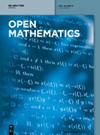求助PDF
{"title":"环形伪微分算子的端点有界性","authors":"Benhamoud Ramla","doi":"10.1515/math-2024-0023","DOIUrl":null,"url":null,"abstract":"In this note, we prove that the toroidal pseudo-differential operator is bounded from <jats:inline-formula> <jats:alternatives> <jats:inline-graphic xmlns:xlink=\"http://www.w3.org/1999/xlink\" xlink:href=\"graphic/j_math-2024-0023_eq_001.png\"/> <m:math xmlns:m=\"http://www.w3.org/1998/Math/MathML\"> <m:msup> <m:mrow> <m:mi>L</m:mi> </m:mrow> <m:mrow> <m:mi>∞</m:mi> </m:mrow> </m:msup> <m:mrow> <m:mo>(</m:mo> <m:mrow> <m:msup> <m:mrow> <m:mi mathvariant=\"double-struck\">T</m:mi> </m:mrow> <m:mrow> <m:mi>n</m:mi> </m:mrow> </m:msup> </m:mrow> <m:mo>)</m:mo> </m:mrow> </m:math> <jats:tex-math>{L}^{\\infty }\\left({{\\mathbb{T}}}^{n})</jats:tex-math> </jats:alternatives> </jats:inline-formula> to <jats:inline-formula> <jats:alternatives> <jats:inline-graphic xmlns:xlink=\"http://www.w3.org/1999/xlink\" xlink:href=\"graphic/j_math-2024-0023_eq_002.png\"/> <m:math xmlns:m=\"http://www.w3.org/1998/Math/MathML\"> <m:mi mathvariant=\"normal\">BMO</m:mi> <m:mrow> <m:mo>(</m:mo> <m:mrow> <m:msup> <m:mrow> <m:mi mathvariant=\"double-struck\">T</m:mi> </m:mrow> <m:mrow> <m:mi>n</m:mi> </m:mrow> </m:msup> </m:mrow> <m:mo>)</m:mo> </m:mrow> </m:math> <jats:tex-math>{\\rm{BMO}}\\left({{\\mathbb{T}}}^{n})</jats:tex-math> </jats:alternatives> </jats:inline-formula> if the symbol belongs to the toroidal Hörmander class <jats:inline-formula> <jats:alternatives> <jats:inline-graphic xmlns:xlink=\"http://www.w3.org/1999/xlink\" xlink:href=\"graphic/j_math-2024-0023_eq_003.png\"/> <m:math xmlns:m=\"http://www.w3.org/1998/Math/MathML\"> <m:msubsup> <m:mrow> <m:mi>S</m:mi> </m:mrow> <m:mrow> <m:mi>ρ</m:mi> <m:mo>,</m:mo> <m:mi>δ</m:mi> </m:mrow> <m:mrow> <m:mi>n</m:mi> <m:mrow> <m:mo>(</m:mo> <m:mrow> <m:mi>ρ</m:mi> <m:mo>−</m:mo> <m:mn>1</m:mn> </m:mrow> <m:mo>)</m:mo> </m:mrow> <m:mo>∕</m:mo> <m:mn>2</m:mn> </m:mrow> </m:msubsup> <m:mrow> <m:mo>(</m:mo> <m:mrow> <m:msup> <m:mrow> <m:mi mathvariant=\"double-struck\">T</m:mi> </m:mrow> <m:mrow> <m:mi>n</m:mi> </m:mrow> </m:msup> <m:mo>×</m:mo> <m:msup> <m:mrow> <m:mi mathvariant=\"double-struck\">Z</m:mi> </m:mrow> <m:mrow> <m:mi>n</m:mi> </m:mrow> </m:msup> </m:mrow> <m:mo>)</m:mo> </m:mrow> </m:math> <jats:tex-math>{S}_{\\rho ,\\delta }^{n\\left(\\rho -1)/2}\\left({{\\mathbb{T}}}^{n}\\times {{\\mathbb{Z}}}^{n})</jats:tex-math> </jats:alternatives> </jats:inline-formula> with <jats:inline-formula> <jats:alternatives> <jats:inline-graphic xmlns:xlink=\"http://www.w3.org/1999/xlink\" xlink:href=\"graphic/j_math-2024-0023_eq_004.png\"/> <m:math xmlns:m=\"http://www.w3.org/1998/Math/MathML\"> <m:mn>0</m:mn> <m:mo><</m:mo> <m:mi>ρ</m:mi> <m:mo>≤</m:mo> <m:mn>1</m:mn> </m:math> <jats:tex-math>0\\lt \\rho \\le 1</jats:tex-math> </jats:alternatives> </jats:inline-formula> and <jats:inline-formula> <jats:alternatives> <jats:inline-graphic xmlns:xlink=\"http://www.w3.org/1999/xlink\" xlink:href=\"graphic/j_math-2024-0023_eq_005.png\"/> <m:math xmlns:m=\"http://www.w3.org/1998/Math/MathML\"> <m:mn>0</m:mn> <m:mo>≤</m:mo> <m:mi>δ</m:mi> <m:mo><</m:mo> <m:mn>1</m:mn> </m:math> <jats:tex-math>0\\le \\delta \\lt 1</jats:tex-math> </jats:alternatives> </jats:inline-formula>. As a corollary, we obtain a result of toroidal pseudo-differential operators on <jats:inline-formula> <jats:alternatives> <jats:inline-graphic xmlns:xlink=\"http://www.w3.org/1999/xlink\" xlink:href=\"graphic/j_math-2024-0023_eq_006.png\"/> <m:math xmlns:m=\"http://www.w3.org/1998/Math/MathML\"> <m:msup> <m:mrow> <m:mi>L</m:mi> </m:mrow> <m:mrow> <m:mi>p</m:mi> </m:mrow> </m:msup> </m:math> <jats:tex-math>{L}^{p}</jats:tex-math> </jats:alternatives> </jats:inline-formula> when <jats:inline-formula> <jats:alternatives> <jats:inline-graphic xmlns:xlink=\"http://www.w3.org/1999/xlink\" xlink:href=\"graphic/j_math-2024-0023_eq_007.png\"/> <m:math xmlns:m=\"http://www.w3.org/1998/Math/MathML\"> <m:mn>2</m:mn> <m:mo><</m:mo> <m:mi>p</m:mi> <m:mo><</m:mo> <m:mi>∞</m:mi> </m:math> <jats:tex-math>2\\lt p\\lt \\infty </jats:tex-math> </jats:alternatives> </jats:inline-formula> for symbols in the class <jats:inline-formula> <jats:alternatives> <jats:inline-graphic xmlns:xlink=\"http://www.w3.org/1999/xlink\" xlink:href=\"graphic/j_math-2024-0023_eq_008.png\"/> <m:math xmlns:m=\"http://www.w3.org/1998/Math/MathML\"> <m:msubsup> <m:mrow> <m:mi>S</m:mi> </m:mrow> <m:mrow> <m:mi>ρ</m:mi> <m:mo>,</m:mo> <m:mi>δ</m:mi> </m:mrow> <m:mrow> <m:mi>m</m:mi> </m:mrow> </m:msubsup> <m:mrow> <m:mo>(</m:mo> <m:mrow> <m:msup> <m:mrow> <m:mi mathvariant=\"double-struck\">T</m:mi> </m:mrow> <m:mrow> <m:mi>n</m:mi> </m:mrow> </m:msup> <m:mo>×</m:mo> <m:msup> <m:mrow> <m:mi mathvariant=\"double-struck\">Z</m:mi> </m:mrow> <m:mrow> <m:mi>n</m:mi> </m:mrow> </m:msup> </m:mrow> <m:mo>)</m:mo> </m:mrow> </m:math> <jats:tex-math>{S}_{\\rho ,\\delta }^{m}\\left({{\\mathbb{T}}}^{n}\\times {{\\mathbb{Z}}}^{n})</jats:tex-math> </jats:alternatives> </jats:inline-formula> with <jats:inline-formula> <jats:alternatives> <jats:inline-graphic xmlns:xlink=\"http://www.w3.org/1999/xlink\" xlink:href=\"graphic/j_math-2024-0023_eq_009.png\"/> <m:math xmlns:m=\"http://www.w3.org/1998/Math/MathML\"> <m:mi>m</m:mi> <m:mo>≤</m:mo> <m:mi>n</m:mi> <m:mrow> <m:mo>(</m:mo> <m:mrow> <m:mi>ρ</m:mi> <m:mo>−</m:mo> <m:mn>1</m:mn> </m:mrow> <m:mo>)</m:mo> </m:mrow> <m:mfenced open=\"(\" close=\")\"> <m:mrow> <m:mfrac> <m:mrow> <m:mn>1</m:mn> </m:mrow> <m:mrow> <m:mn>2</m:mn> </m:mrow> </m:mfrac> <m:mo>−</m:mo> <m:mfrac> <m:mrow> <m:mn>1</m:mn> </m:mrow> <m:mrow> <m:mi>p</m:mi> </m:mrow> </m:mfrac> </m:mrow> </m:mfenced> <m:mo>+</m:mo> <m:mfrac> <m:mrow> <m:mi>n</m:mi> </m:mrow> <m:mrow> <m:mi>p</m:mi> </m:mrow> </m:mfrac> <m:mi>min</m:mi> <m:mrow> <m:mo>{</m:mo> <m:mrow> <m:mn>0</m:mn> <m:mo>,</m:mo> <m:mi>ρ</m:mi> <m:mo>−</m:mo> <m:mi>δ</m:mi> </m:mrow> <m:mo>}</m:mo> </m:mrow> </m:math> <jats:tex-math>m\\le n\\left(\\rho -1)\\left(\\phantom{\\rule[-0.75em]{}{0ex}},\\frac{1}{2}-\\frac{1}{p}\\right)+\\frac{n}{p}\\min \\left\\{0,\\rho -\\delta \\right\\}</jats:tex-math> </jats:alternatives> </jats:inline-formula>.","PeriodicalId":48713,"journal":{"name":"Open Mathematics","volume":"159 1","pages":""},"PeriodicalIF":0.9000,"publicationDate":"2024-08-02","publicationTypes":"Journal Article","fieldsOfStudy":null,"isOpenAccess":false,"openAccessPdf":"","citationCount":"0","resultStr":"{\"title\":\"Endpoint boundedness of toroidal pseudo-differential operators\",\"authors\":\"Benhamoud Ramla\",\"doi\":\"10.1515/math-2024-0023\",\"DOIUrl\":null,\"url\":null,\"abstract\":\"In this note, we prove that the toroidal pseudo-differential operator is bounded from <jats:inline-formula> <jats:alternatives> <jats:inline-graphic xmlns:xlink=\\\"http://www.w3.org/1999/xlink\\\" xlink:href=\\\"graphic/j_math-2024-0023_eq_001.png\\\"/> <m:math xmlns:m=\\\"http://www.w3.org/1998/Math/MathML\\\"> <m:msup> <m:mrow> <m:mi>L</m:mi> </m:mrow> <m:mrow> <m:mi>∞</m:mi> </m:mrow> </m:msup> <m:mrow> <m:mo>(</m:mo> <m:mrow> <m:msup> <m:mrow> <m:mi mathvariant=\\\"double-struck\\\">T</m:mi> </m:mrow> <m:mrow> <m:mi>n</m:mi> </m:mrow> </m:msup> </m:mrow> <m:mo>)</m:mo> </m:mrow> </m:math> <jats:tex-math>{L}^{\\\\infty }\\\\left({{\\\\mathbb{T}}}^{n})</jats:tex-math> </jats:alternatives> </jats:inline-formula> to <jats:inline-formula> <jats:alternatives> <jats:inline-graphic xmlns:xlink=\\\"http://www.w3.org/1999/xlink\\\" xlink:href=\\\"graphic/j_math-2024-0023_eq_002.png\\\"/> <m:math xmlns:m=\\\"http://www.w3.org/1998/Math/MathML\\\"> <m:mi mathvariant=\\\"normal\\\">BMO</m:mi> <m:mrow> <m:mo>(</m:mo> <m:mrow> <m:msup> <m:mrow> <m:mi mathvariant=\\\"double-struck\\\">T</m:mi> </m:mrow> <m:mrow> <m:mi>n</m:mi> </m:mrow> </m:msup> </m:mrow> <m:mo>)</m:mo> </m:mrow> </m:math> <jats:tex-math>{\\\\rm{BMO}}\\\\left({{\\\\mathbb{T}}}^{n})</jats:tex-math> </jats:alternatives> </jats:inline-formula> if the symbol belongs to the toroidal Hörmander class <jats:inline-formula> <jats:alternatives> <jats:inline-graphic xmlns:xlink=\\\"http://www.w3.org/1999/xlink\\\" xlink:href=\\\"graphic/j_math-2024-0023_eq_003.png\\\"/> <m:math xmlns:m=\\\"http://www.w3.org/1998/Math/MathML\\\"> <m:msubsup> <m:mrow> <m:mi>S</m:mi> </m:mrow> <m:mrow> <m:mi>ρ</m:mi> <m:mo>,</m:mo> <m:mi>δ</m:mi> </m:mrow> <m:mrow> <m:mi>n</m:mi> <m:mrow> <m:mo>(</m:mo> <m:mrow> <m:mi>ρ</m:mi> <m:mo>−</m:mo> <m:mn>1</m:mn> </m:mrow> <m:mo>)</m:mo> </m:mrow> <m:mo>∕</m:mo> <m:mn>2</m:mn> </m:mrow> </m:msubsup> <m:mrow> <m:mo>(</m:mo> <m:mrow> <m:msup> <m:mrow> <m:mi mathvariant=\\\"double-struck\\\">T</m:mi> </m:mrow> <m:mrow> <m:mi>n</m:mi> </m:mrow> </m:msup> <m:mo>×</m:mo> <m:msup> <m:mrow> <m:mi mathvariant=\\\"double-struck\\\">Z</m:mi> </m:mrow> <m:mrow> <m:mi>n</m:mi> </m:mrow> </m:msup> </m:mrow> <m:mo>)</m:mo> </m:mrow> </m:math> <jats:tex-math>{S}_{\\\\rho ,\\\\delta }^{n\\\\left(\\\\rho -1)/2}\\\\left({{\\\\mathbb{T}}}^{n}\\\\times {{\\\\mathbb{Z}}}^{n})</jats:tex-math> </jats:alternatives> </jats:inline-formula> with <jats:inline-formula> <jats:alternatives> <jats:inline-graphic xmlns:xlink=\\\"http://www.w3.org/1999/xlink\\\" xlink:href=\\\"graphic/j_math-2024-0023_eq_004.png\\\"/> <m:math xmlns:m=\\\"http://www.w3.org/1998/Math/MathML\\\"> <m:mn>0</m:mn> <m:mo><</m:mo> <m:mi>ρ</m:mi> <m:mo>≤</m:mo> <m:mn>1</m:mn> </m:math> <jats:tex-math>0\\\\lt \\\\rho \\\\le 1</jats:tex-math> </jats:alternatives> </jats:inline-formula> and <jats:inline-formula> <jats:alternatives> <jats:inline-graphic xmlns:xlink=\\\"http://www.w3.org/1999/xlink\\\" xlink:href=\\\"graphic/j_math-2024-0023_eq_005.png\\\"/> <m:math xmlns:m=\\\"http://www.w3.org/1998/Math/MathML\\\"> <m:mn>0</m:mn> <m:mo>≤</m:mo> <m:mi>δ</m:mi> <m:mo><</m:mo> <m:mn>1</m:mn> </m:math> <jats:tex-math>0\\\\le \\\\delta \\\\lt 1</jats:tex-math> </jats:alternatives> </jats:inline-formula>. As a corollary, we obtain a result of toroidal pseudo-differential operators on <jats:inline-formula> <jats:alternatives> <jats:inline-graphic xmlns:xlink=\\\"http://www.w3.org/1999/xlink\\\" xlink:href=\\\"graphic/j_math-2024-0023_eq_006.png\\\"/> <m:math xmlns:m=\\\"http://www.w3.org/1998/Math/MathML\\\"> <m:msup> <m:mrow> <m:mi>L</m:mi> </m:mrow> <m:mrow> <m:mi>p</m:mi> </m:mrow> </m:msup> </m:math> <jats:tex-math>{L}^{p}</jats:tex-math> </jats:alternatives> </jats:inline-formula> when <jats:inline-formula> <jats:alternatives> <jats:inline-graphic xmlns:xlink=\\\"http://www.w3.org/1999/xlink\\\" xlink:href=\\\"graphic/j_math-2024-0023_eq_007.png\\\"/> <m:math xmlns:m=\\\"http://www.w3.org/1998/Math/MathML\\\"> <m:mn>2</m:mn> <m:mo><</m:mo> <m:mi>p</m:mi> <m:mo><</m:mo> <m:mi>∞</m:mi> </m:math> <jats:tex-math>2\\\\lt p\\\\lt \\\\infty </jats:tex-math> </jats:alternatives> </jats:inline-formula> for symbols in the class <jats:inline-formula> <jats:alternatives> <jats:inline-graphic xmlns:xlink=\\\"http://www.w3.org/1999/xlink\\\" xlink:href=\\\"graphic/j_math-2024-0023_eq_008.png\\\"/> <m:math xmlns:m=\\\"http://www.w3.org/1998/Math/MathML\\\"> <m:msubsup> <m:mrow> <m:mi>S</m:mi> </m:mrow> <m:mrow> <m:mi>ρ</m:mi> <m:mo>,</m:mo> <m:mi>δ</m:mi> </m:mrow> <m:mrow> <m:mi>m</m:mi> </m:mrow> </m:msubsup> <m:mrow> <m:mo>(</m:mo> <m:mrow> <m:msup> <m:mrow> <m:mi mathvariant=\\\"double-struck\\\">T</m:mi> </m:mrow> <m:mrow> <m:mi>n</m:mi> </m:mrow> </m:msup> <m:mo>×</m:mo> <m:msup> <m:mrow> <m:mi mathvariant=\\\"double-struck\\\">Z</m:mi> </m:mrow> <m:mrow> <m:mi>n</m:mi> </m:mrow> </m:msup> </m:mrow> <m:mo>)</m:mo> </m:mrow> </m:math> <jats:tex-math>{S}_{\\\\rho ,\\\\delta }^{m}\\\\left({{\\\\mathbb{T}}}^{n}\\\\times {{\\\\mathbb{Z}}}^{n})</jats:tex-math> </jats:alternatives> </jats:inline-formula> with <jats:inline-formula> <jats:alternatives> <jats:inline-graphic xmlns:xlink=\\\"http://www.w3.org/1999/xlink\\\" xlink:href=\\\"graphic/j_math-2024-0023_eq_009.png\\\"/> <m:math xmlns:m=\\\"http://www.w3.org/1998/Math/MathML\\\"> <m:mi>m</m:mi> <m:mo>≤</m:mo> <m:mi>n</m:mi> <m:mrow> <m:mo>(</m:mo> <m:mrow> <m:mi>ρ</m:mi> <m:mo>−</m:mo> <m:mn>1</m:mn> </m:mrow> <m:mo>)</m:mo> </m:mrow> <m:mfenced open=\\\"(\\\" close=\\\")\\\"> <m:mrow> <m:mfrac> <m:mrow> <m:mn>1</m:mn> </m:mrow> <m:mrow> <m:mn>2</m:mn> </m:mrow> </m:mfrac> <m:mo>−</m:mo> <m:mfrac> <m:mrow> <m:mn>1</m:mn> </m:mrow> <m:mrow> <m:mi>p</m:mi> </m:mrow> </m:mfrac> </m:mrow> </m:mfenced> <m:mo>+</m:mo> <m:mfrac> <m:mrow> <m:mi>n</m:mi> </m:mrow> <m:mrow> <m:mi>p</m:mi> </m:mrow> </m:mfrac> <m:mi>min</m:mi> <m:mrow> <m:mo>{</m:mo> <m:mrow> <m:mn>0</m:mn> <m:mo>,</m:mo> <m:mi>ρ</m:mi> <m:mo>−</m:mo> <m:mi>δ</m:mi> </m:mrow> <m:mo>}</m:mo> </m:mrow> </m:math> <jats:tex-math>m\\\\le n\\\\left(\\\\rho -1)\\\\left(\\\\phantom{\\\\rule[-0.75em]{}{0ex}},\\\\frac{1}{2}-\\\\frac{1}{p}\\\\right)+\\\\frac{n}{p}\\\\min \\\\left\\\\{0,\\\\rho -\\\\delta \\\\right\\\\}</jats:tex-math> </jats:alternatives> </jats:inline-formula>.\",\"PeriodicalId\":48713,\"journal\":{\"name\":\"Open Mathematics\",\"volume\":\"159 1\",\"pages\":\"\"},\"PeriodicalIF\":0.9000,\"publicationDate\":\"2024-08-02\",\"publicationTypes\":\"Journal Article\",\"fieldsOfStudy\":null,\"isOpenAccess\":false,\"openAccessPdf\":\"\",\"citationCount\":\"0\",\"resultStr\":null,\"platform\":\"Semanticscholar\",\"paperid\":null,\"PeriodicalName\":\"Open Mathematics\",\"FirstCategoryId\":\"100\",\"ListUrlMain\":\"https://doi.org/10.1515/math-2024-0023\",\"RegionNum\":4,\"RegionCategory\":\"数学\",\"ArticlePicture\":[],\"TitleCN\":null,\"AbstractTextCN\":null,\"PMCID\":null,\"EPubDate\":\"\",\"PubModel\":\"\",\"JCR\":\"Q1\",\"JCRName\":\"MATHEMATICS\",\"Score\":null,\"Total\":0}","platform":"Semanticscholar","paperid":null,"PeriodicalName":"Open Mathematics","FirstCategoryId":"100","ListUrlMain":"https://doi.org/10.1515/math-2024-0023","RegionNum":4,"RegionCategory":"数学","ArticlePicture":[],"TitleCN":null,"AbstractTextCN":null,"PMCID":null,"EPubDate":"","PubModel":"","JCR":"Q1","JCRName":"MATHEMATICS","Score":null,"Total":0}
引用次数: 0
引用
批量引用
Endpoint boundedness of toroidal pseudo-differential operators
In this note, we prove that the toroidal pseudo-differential operator is bounded from L ∞ ( T n ) {L}^{\infty }\left({{\mathbb{T}}}^{n}) to BMO ( T n ) {\rm{BMO}}\left({{\mathbb{T}}}^{n}) if the symbol belongs to the toroidal Hörmander class S ρ , δ n ( ρ − 1 ) ∕ 2 ( T n × Z n ) {S}_{\rho ,\delta }^{n\left(\rho -1)/2}\left({{\mathbb{T}}}^{n}\times {{\mathbb{Z}}}^{n}) with 0 < ρ ≤ 1 0\lt \rho \le 1 and 0 ≤ δ < 1 0\le \delta \lt 1 . As a corollary, we obtain a result of toroidal pseudo-differential operators on L p {L}^{p} when 2 < p < ∞ 2\lt p\lt \infty for symbols in the class S ρ , δ m ( T n × Z n ) {S}_{\rho ,\delta }^{m}\left({{\mathbb{T}}}^{n}\times {{\mathbb{Z}}}^{n}) with m ≤ n ( ρ − 1 ) 1 2 − 1 p + n p min { 0 , ρ − δ } m\le n\left(\rho -1)\left(\phantom{\rule[-0.75em]{}{0ex}},\frac{1}{2}-\frac{1}{p}\right)+\frac{n}{p}\min \left\{0,\rho -\delta \right\} .

 求助内容:
求助内容: 应助结果提醒方式:
应助结果提醒方式:


